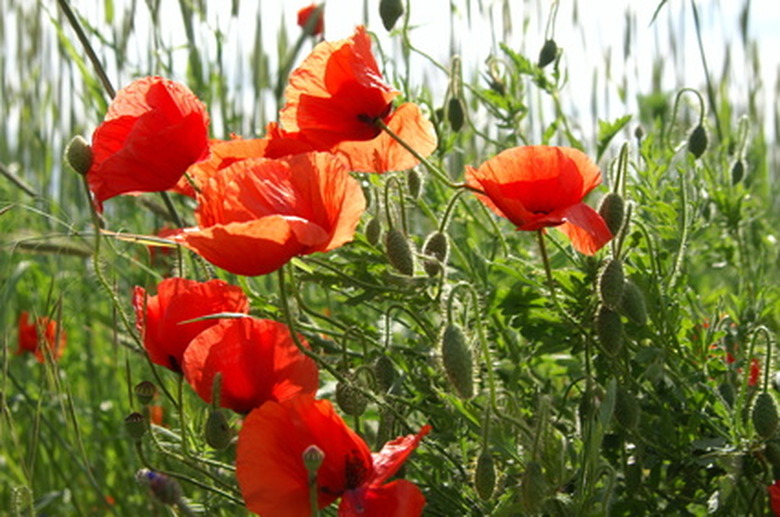Parts Of A Poppy Flower
Poppies, from the Papaveraceae family, are a genus of flowering plants with delicate, papery petals in a variety of shapes and vibrant hues. According to online horticulture resource Floridata, there are more than 70 distinct species in the poppy (papaver) genus, including opium poppies (Papaver somniferum), corn poppies (Papaver rhoeas) and Oriental poppies (Papaver orientale). Poppies are an excellent addition to mixed beds, borders and cut arrangements.
Sepals
The outermost part of the poppy flower is the sepals. In the early stages of development, the sepals resemble two individual, yet partially joined, orbs which gradually lengthen and split lengthwise as the developing flower prepares to bloom. The foliage, stem and sepals are covered with thousands of fine hairs that protect the bud and plant from insect attack. The sepals, light green during early growth, turn to a pale shade of beige towards the end of their tenure. Once the flower is ready to bloom, the sepals detach from the stem and eventually fall away when the poppy flower unfurls its matured petals.
- Poppies, from the Papaveraceae family, are a genus of flowering plants with delicate, papery petals in a variety of shapes and vibrant hues.
- Once the flower is ready to bloom, the sepals detach from the stem and eventually fall away when the poppy flower unfurls its matured petals.
Petals
Poppy flowers consist of crepe-paper petals in bright shades of orange, yellow, red, pink, white, peach, purple and an array of variegated designs, depending on the specific poppy variety. Petal construct also differs with variety, including single, double, semi-double, peony and tulip shapes. Apart from providing beauty, the general purpose of poppy petals is to attract birds and insects to assist with pollination.
Stamen
Attached to the delicate petals are several rings of stamens, the male reproductive portion of the poppy flower. Each stamen consists of fine whitish filaments that support anthers, which carry thousands of pollen grains needed to fertilize the flower. Once pollination is completed, stamens fall away with the wilting petals.
Pistil
The female reproductive organs, known collectively as the pistil, are in the center of the poppy flower. The melon-shaped ovary sits at the bottom of the bloom, surrounded on all sides by the petals and stamens, which protect it during the early stages of formation. More tiny hairs also coat the outside of the ovary, pointing upward to the point where a very short style (stem) supports the stigma. The stigma is the portion that receives pollen, fertilizing the ovary. The intricate, star-shaped stigma is often coated with sticky nectar and microscopic hairs.
- Poppy flowers consist of crepe-paper petals in bright shades of orange, yellow, red, pink, white, peach, purple and an array of variegated designs, depending on the specific poppy variety.
- The melon-shaped ovary sits at the bottom of the bloom, surrounded on all sides by the petals and stamens, which protect it during the early stages of formation.
Ovary
The ovary, which begins to develop while the bloom is still covered by the sepals, starts out in a nearly cylindrical shape. Once pollination occurs, the ovary begins to swell because the ovules inside fuse with entering pollen grains to form the seeds to continue propagation of the plant. In opium poppies, it is the ovary that contains the prized substance called latex. The milky substance contains raw opium which is used to create legal drugs such as morphine and codeine and the illegal, addictive street drug, heroin.
